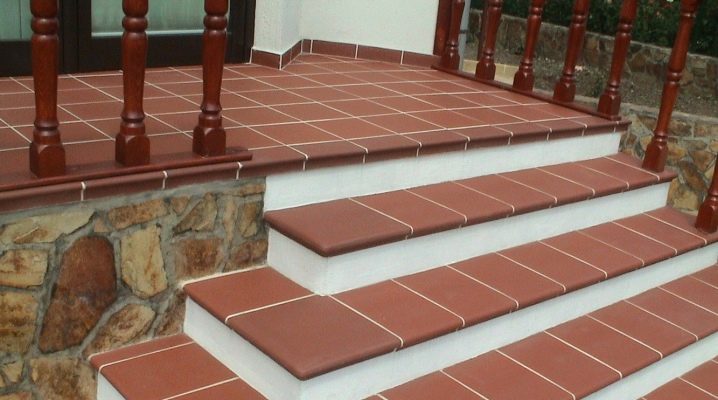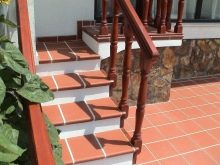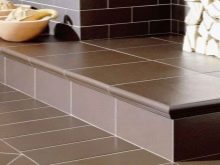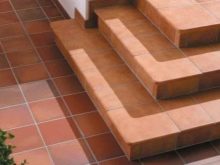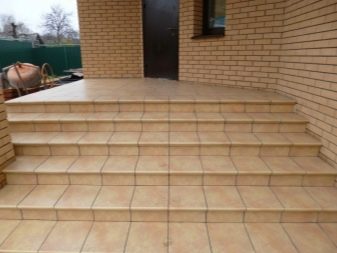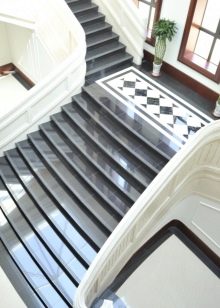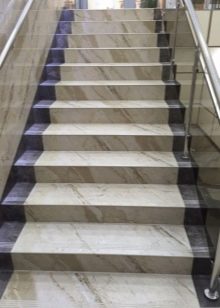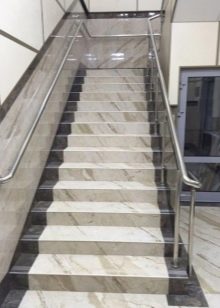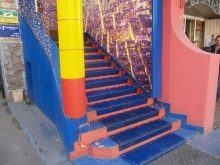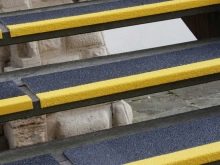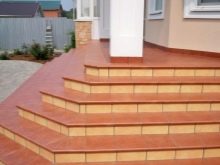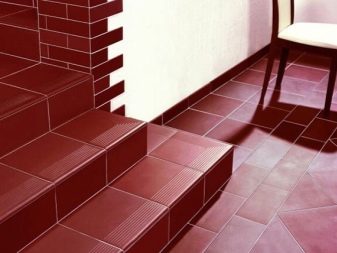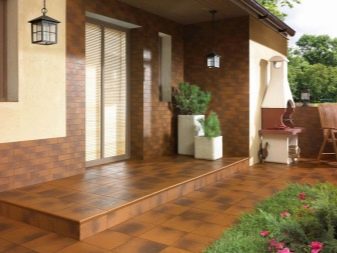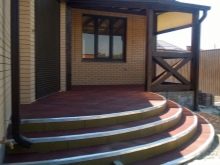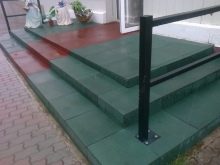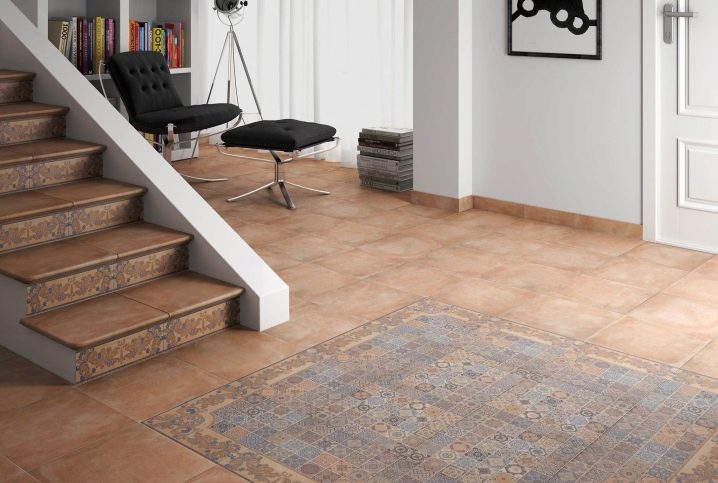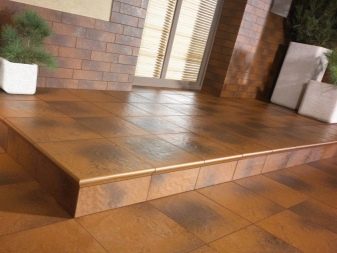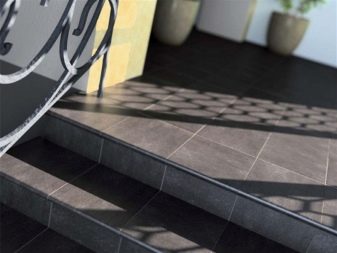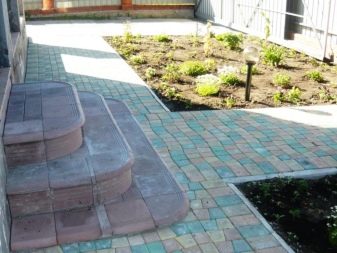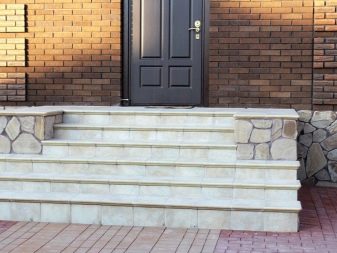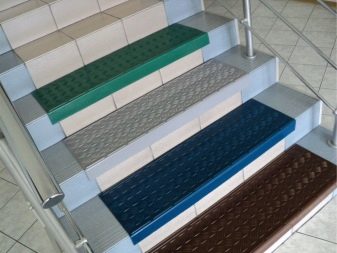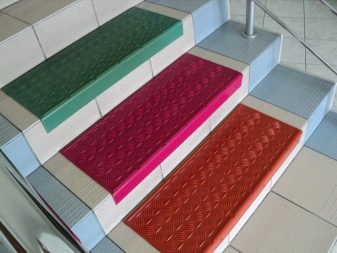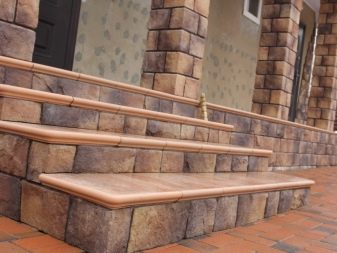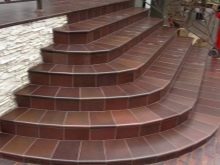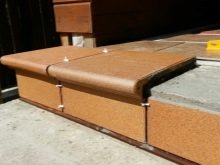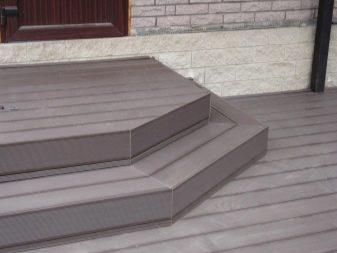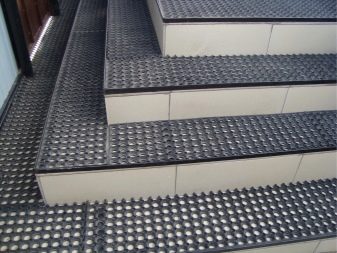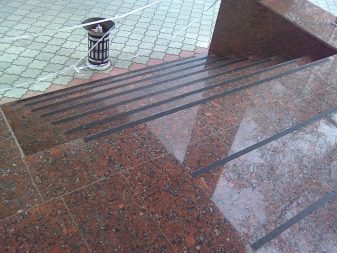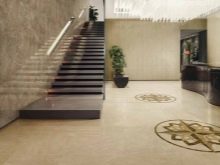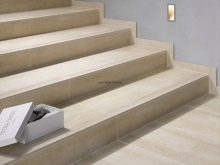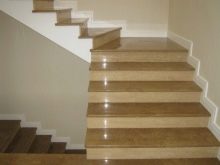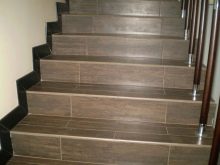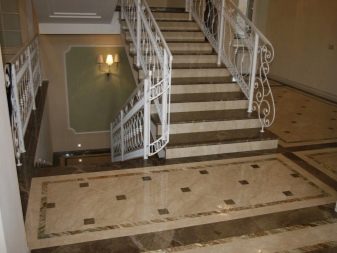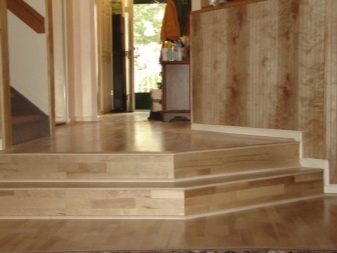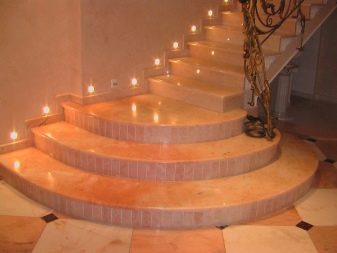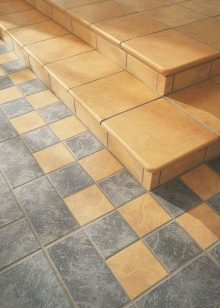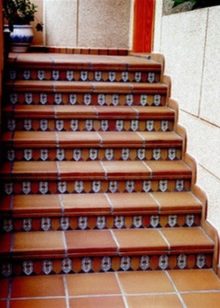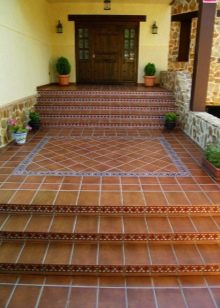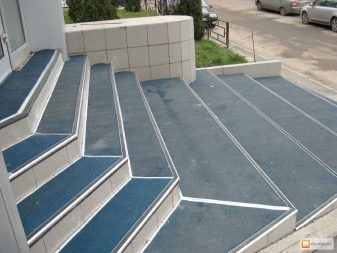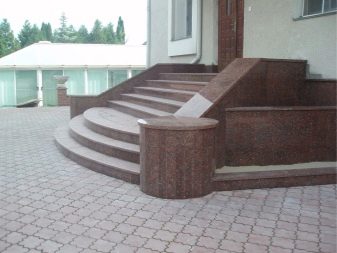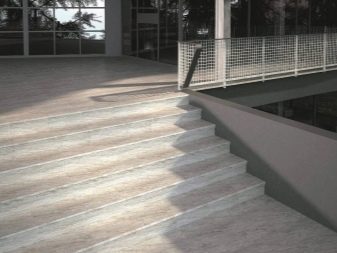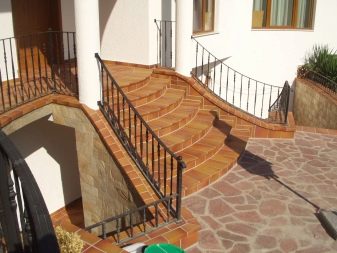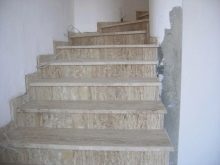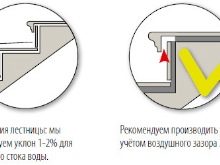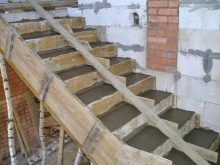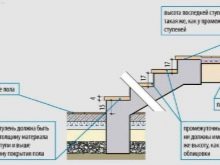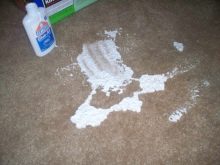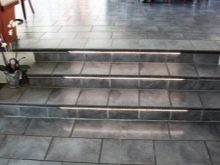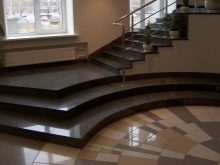Tile for steps: types and characteristics
Ladders - the ingenious invention of mankind. They allow you to quickly move between floors and different levels of the surface on the street. These structures from a number of steps can be seen everywhere - in the park, in a private house or in the country, in a public building. We use them, sometimes not even paying attention to them, unless the staircase is not a masterpiece of design.
To move up and down was comfortable and safe, you need competent finishing of the steps with special tiles. It should be durable, resistant to mechanical stress and, of course, beautiful.
Special features
When it comes to facing tiles for the stairs, it must be understood that all the steps have two faces. This is, in fact, the step itself, or, in other words, the tread - the surface on which they step when walking, and the riser - the vertical part of the step.It is her best seen when looking at the stairs from the side. It is not by chance that the risers' tiles are often decorated with drawings, creating a unique image of the stepped structure as a whole.
The design of the steps determines the shape of the tile, which they get off.
Ladders are installed in different places. And the impact of the external environment, depending on this on the facing layer, is completely different. It's one thing - a ladder in the pool or sauna, another - on the porch. Tiles for certain places of operation have completely different “life”. Accordingly, its properties should be different.
Kinds
Types of tiles for stairs can vary in shape, method of manufacture, type of installation, the material from which they are made, in color.
There are two main types of steps:
- Steps with notches. This is the most inexpensive type of steps, which is bought in square meters. On this coating is applied notches that prevent slipping. Furrows create a press before firing the tile or cut mechanically. This kind of finishing materials suitable for stairs of any size. With their help, revet the very level and risers.
Sometimes the nose of the stair or, as they say, the beak, is sold separately as a connecting element between the tread and the riser.
- Steps with a nose (capinos). They have one curved side, which allows you to protect the floor of the stairs from damage. Also thanks to this moisture does not penetrate the seams of the finishing layer. Such a tile is sold by the piece, and its price is higher than the usual facing.
Materials
If there is a need for tiling the stairs, there are several choices depending on the material from which the lining is created.
Such types of a tile are most popular:
- ceramic granite;
- clinker;
- rubber;
- ceramic;
- concrete
Porcelain stoneware consists of different grades of clay, it also contains quartz and feldspar, which provide the material with particular reliability and durability. This artificial stone is more expensive than ordinary ceramics, but this price is justified by the durability and functionality of this tile, both indoors and on external stairs.
The brick tile is considered as a universal facing material. By nature, it is an improved version of ceramic.Such a product is obtained from a mixture of simple and shale clays, as well as some other components by extrusion, in other words, roasting. As a result, the density of the material increases, and the porosity decreases.
This prevents the ingress of moisture into the material and creates resistance to temperature changes. This quality coverage will be enough for 50 cycles of extreme cold.
Clinker allows you to equally make the steps of the stairs inside and outside the building. Such a tile has a rounded corner, making it possible to make the step not sharp, but with a rounded edge. This roundness also helps to hide the joint with the risers. Stairs and inside the house, and on the porch, decorated with such material, will look in the same style and equally elegant.
For the porch is well suited rubber tiles. On the one hand, compared to ceramic, it is more affordable, on the other - practically does not slip, which is very important in terms of functionality and safety of such a coating.
As a rule, it is made from waste - used tires, rubber and rubber. All this is crushed and "mixed" with polyurethane and other components, including coloring pigments. Then from such a plastic mass make elements of the future coating.
To the touch they are rough, which allows them to achieve a high level of adhesion with the soles of shoes. Due to its elasticity, such a material has the property to extinguish a blow, which increases the safety of movement on stairs.
Rubber tile is resistant to moisture and mechanical stress. It retains its properties at temperatures from -40 to +80 degrees Celsius. It can be laid on any base - wood, concrete, brick, metal.
Another issue is that its service life is limited - only 10 years.
The range of ceramic tiles on the market is very large. Its different types have different surface properties. It can be glossy, glazed, embossed, convex, concave. For outdoor stairs is better to choose a product of double firing. It well maintains mechanical loadings and temperature drops.
Concrete tiles are also well suited for the porch. Its dense structure makes the coating resistant to moisture. It does not absorb dirt, which makes it easy to wash the steps. Long serves and does not wear out. But do not clean this coating with chemical agents. This can lead to its deformation.
Colors
The modern market offers an incredible amount of tile color for facing stairs, which opens up a wide scope for designers' creativity. You can choose the option with a pattern, under a stone, under a tree, traditional terracotta tiles. Black or white ladder will look impressive.
And the rubber tile is full of all the colors of the rainbow, because when creating this material any pigment is added to it. Therefore, we can conclude that the choice of color depends only on the taste of a particular customer.
Dimensions
There is no single standard for the size of finishing tiles that the construction market provides. The only thing that you can accurately focus on is the requirements for the size of the steps, and other parameters when setting up the stairs.
On this basis, when choosing, for example, porcelain stoneware, it is easy to choose ready-made steps. You can focus on the parameters of 1200x300x10 mm.
Clinker tiles for steps, as a rule, have a length of 30 cm, and its width can vary from 20 to 35 cm.
Rubber is available in size 500 by 500 mm. On the one hand, the product may have a protrusion of 20 - 40 mm.This part should protrude beyond the edge of the step, covering the risers.
Ceramic tiles of 30 by 30 or 30 by 60 cm are considered to be optimal for finishing.
In any case, before starting to finish the stairs, you will have to find out the dimensions of the selected products, and make all the necessary calculations.
Which is better to choose?
When choosing a tile, you need to take into account a lot of nuances:
- the design of the staircases themselves, their parameters, the area of turning platforms, and so on;
- the degree of patency of stair structures;
- front staircase or not. Depending on this, you can choose a plain tile or, on the contrary, with a spectacular design on the front side of the steps.
It is important where the tile is located - on the street or in the house. In some cases, the product must be anti-slip. It may be, for example, with notches, which to a certain extent is the anti-slip base of this element of the coating.
It is necessary to consider the basis on which the tile will be laid. For example, for a concrete staircase or porch.
Tile design options matter. So, in some cases, among other things, it is convenient to choose a corner tile, which simplifies the finishing of the edges of the steps.When leaning in favor of one or another coverage, one should keep in mind whether the manufacturer has such offers.
Important and customer reviews. On the market, you can choose Russian tiles or foreign-made, but in order not to be mistaken, it is always better to rely on the mistakes of others in the choice of products of a particular manufacturer.
Inside the house
Choosing a tile for the house, you need to pay attention to the following:
- It is better to purchase products with a coating that does not slip. Indoors, this property is no less important than outdoor.
- You always want to decorate the stairs in such a way that for many years this question would not bother again. Therefore, you need to choose only quality products for which there is a corresponding certificate.
- The degree of strength of the tiles should be indicated by the manufacturer on the package. Consultation with the seller on this issue also will not be superfluous.
- If products from a particular manufacturer or in the assortment of the store differ in a variety of colors, textures and patterns, consider yourself lucky. In professional outlets, there is also a service for preparing a 3D model of a staircase in one way or another.Often this simulation is free for the buyer.
- The tile must be the same color and size. On quality products can not be scuffed and chipped. To avoid trouble, make sure to check the articles and batch numbers when purchasing.
- The tile should correspond to the sizes of steps and risers.
- It is better to choose the brand of products to which the accompanying elements are attached, such as limiters, baseboards and corners.
- It is better to choose a tile that is easy to wash.
On the street
In addition to the anti-slip effect, the tile for the stairs on the street should have greater wear resistance, because the load on such a coating is usually very serious.
Even the appearance of the tile can tell how it meets the requirements of durability. The thinner and larger it is, the less quality it is.
Also important is the resistance of the product to temperature extremes. In Russian conditions, its frost resistance is of great importance.
Not the last requirement for the finishing of street stairs is the ability of the material to resist abrasive impacts not only from the soles of the shoes, but also from sand, small stones and salt brought on shoes from footpaths and the roadway.
Laying technology
The technology of finishing the stairs with tiles may differ depending on what form the steps of the stairs, for example, round. From what tile is chosen for finishing, including a basis of which it is made. You should also consider the shape of the products themselves, for example, with capinos.
- Prior to laying, you need to properly prepare the steps themselves. Remove dust, remove dirt and mortar residues.
- To make a marking and to think over the plan of laying of a covering.
- If the riser should be decorated with a picture, think how exactly to place it.
- Mark the places on the stairs where you will have to lay cut pieces of tile, as well as calculate their number.
- According to the instructions to prepare the adhesive solution.
As for the styling process itself, there are options. Some masters prefer to lay tiles first with horizontal surfaces, and then vertical, others - vice versa. Much depends on the specific situation and specific material.
In any case, the installation is better to produce at a temperature of about +20 degrees C.
It is more convenient to apply glue to the tile with a serrated trowel.
After fixing the tile on the surface, it is necessary to knock it with a rubber hammer, achieving maximum adhesion of the finishing material to the base.
It is better to remove traces of glue with a wet sponge as soon as this glue has appeared.
Examples in the interior
Tiled stairs can look just neat and dignified, without glaring. And can be a subject of pride, striking their "outfit".
The staircase, decorated with ceramic tiles in a combination of black and white against the background of the "golden" interior, looks solemn and impressive. The use of material of opposite colors seems to be difficult to call a clever design technique. But even with it, it is easy to make the stairs “rich”.
Dark marble inserts will enliven the dark tiles on the steps of the porch. Their combination with the general design of the entrance to the building will make a simple design decision more interesting.
The original form of the staircase with steps located in a semicircle is emphasized by the combination of light brown ceramic tiles with an ornament on the risers, giving the building an elegant look.
About the features of laying tiles on the steps, see the following video.
